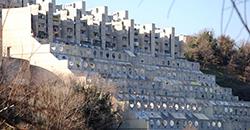A social housing district with poor insulation, a municipality that is meeting a long-standing demand by residents while transforming the area into a model for eco-sustainability

San Pietro is a peripheral neighbourhood overlooking the city of Genoa, North-West of Italy. It is also known as Lavatrici (washing machines), because of the concrete slabs with empty circles that characterise the façades of its buildings.
Erected between 1980 and 1990, it is considered as an example of concrete-based overbuilding and not planned with the modern technology of energy efficiency. In the future it could well become a model for eco-sustainability.
The complex contains 688 apartments, 438 of which belong to the municipality and are used as council housing. Until recently the buildings envelopes lacked good insulation. This led to high energy consumption and high CO2 emissions. For the tenants, this primarily meant high energy bills with little reward.
“The windows did not shut well, there were draughts and rainwater infiltrations: in winter time, even with the heating on we hardly reached 16 degrees,” says Sergio Pandolfini, president of the San Pietro's neighbourhood committee. “At the same time heating is where, until now, we spend most of our money.”
Pandolfini says that they had been requiring interventions to solve these problems for a long time.
In spring 2015 Genoa municipality has started to implement experimental interventions aiming to improve the energy efficiency of two council housing buildings, comprising of a total 162 apartments. The works are being performed under the European project R2CITIES, which aims at designing large scale district renovations for achieving nearly zero energy cities. The old laminated steel windows, which had no thermal insulation, have been replaced with new ones in PVC frame and double glass, which do ensure a high thermal insulation.
“We have already carried out about 60% of the work and plan to finish by 6 January 2016,” says Michele Finocchiaro, architect at the Housing Active Policies Department of Genoa Municipality, who is following the works together with the technical staff of the municipality. “In winter time we will be able to assess if there is an actual improvement, but we can already see that the new windows have changed the appearance of the apartments for the better,” Pandolfini highlights.
Not only is the passive protection of indoor spaces being addressed, but also active energy efficiency.
“The old boiler has been substituted with a highly efficient one, while all the apartments have been equipped with internal satellites that allow users to directly manage the heat,” explains Mirco Grassi, head of the municipality's Public Works Department and technical manager of the project.
According to Grassi, the possibility for tenants to fully decide the amount of heat they desire is likely to lead to more responsible user behaviour: “The warmer they want their indoor climate to be, the more they will consume, so they will try to minimise the cost and therefore the heat consumption. This will lead to less CO2 emissions and air pollution.”
In the future a new rooftop photovoltaic plant will power the lifts and the stairway lighting.
Furthermore, four apartments will become “on-site labs”, where the University of Genova will measure temperature and humidity for one year after the works have been completed, to monitor the energy savings achieved.
According to Pandolfini, the benefits from this project will even go beyond that: “If we can have a better indoor climate and save money from heating, our quality of life and behaviour will improve, and our overall wellbeing will improve: there is much expectation in this sense.”
Genoa Municipality is trying to keep an open dialogue with the inhabitants through several initiatives. During an event called OpenHouse, organised within the My Smart City District initiative over the EU Sustainable Energy Week 2015, tenants had the chance to be guided through the apartments where the improvement works are taking place, and through the situ experimental passive techniques laboratory.
Disclaimer: The views expressed here are those of the author expressed in their private capacity and do not necessarily represent the views of AZoM.com Limited T/A AZoNetwork the owner and operator of this website. This disclaimer forms part of the Terms and conditions of use of this website.